
This is my own personal list of the top films of the early 50's. It includes my own views, as well as views from e-mails, other critics and websites. I tried to include films from all the main genres; including, war, horror, sci-fi, romance, kid's, etc. As well as movies that were groundbreaking from a technology point of view or changed the industry in some way. I did not include foreign films. The top films are placed in alphabetical order. Each are great in their own way and would be quite difficult to arrange in a 1-15 list. The movie titles are linked to the IMDB (Internet Movie Database) which contains extra information on each film, including the cast and crew. To get back to my site from this link, you will need to use the "back" button. By viewing these 15 films, I believe you will have a great feel for what the American film was all about in the early 50's.
The African Queen (1951)
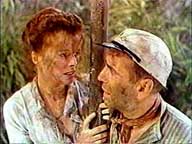 If anything, this film paired two of the all-time legends of Hollywood, Humphrey Bogart and Katharine Hepburn. The story centers around Rose, a spinsterish missionary who becomes stranded at her East African Mission when the Germans attack during WWI. She is reluctantly picked up by Charlie, a boozing, tugboat captain and they flee downriver on the rickety boat named "African Queen". Their personalities immediately begin to clash, but the dangerous adventure begins to pulls them closer and closer. They encounter leeches, swarms of insects, water rapids, being fired upon and dead ends which all leaves to Rose and Charlie falling in love. They end up becoming one of the cinema's most touching and romantic couples. By the end of the film, they decide to try and blow up a German battleship. The film would go on to influence other movies, including the 80's "Romancing the Stone" as well as inspire Walt Disney to develop the Jungle Cruise ride for Disneyland. Appears on AFI's list of best films at #17.
If anything, this film paired two of the all-time legends of Hollywood, Humphrey Bogart and Katharine Hepburn. The story centers around Rose, a spinsterish missionary who becomes stranded at her East African Mission when the Germans attack during WWI. She is reluctantly picked up by Charlie, a boozing, tugboat captain and they flee downriver on the rickety boat named "African Queen". Their personalities immediately begin to clash, but the dangerous adventure begins to pulls them closer and closer. They encounter leeches, swarms of insects, water rapids, being fired upon and dead ends which all leaves to Rose and Charlie falling in love. They end up becoming one of the cinema's most touching and romantic couples. By the end of the film, they decide to try and blow up a German battleship. The film would go on to influence other movies, including the 80's "Romancing the Stone" as well as inspire Walt Disney to develop the Jungle Cruise ride for Disneyland. Appears on AFI's list of best films at #17.
All About Eve (1950)

 A true classic that helped restart the career of a Hollywood legend. Bette Davis, in one of her best roles, plays Margo Channing, an aging actress of the stage. Eve Harrington, a young "fan" played by Anne Baxter, comes to see Davis every night and finally gets to meet her idol one evening after the performance. The older actress is somewhat fond of the young woman and begins mentoring her. Little does she know that the woman has her own plans of replacing Davis. The films supporting cast is topnotch. Gary Merrill plays Margo's loyal husband. Hugh Marlowe is the playwright who succumbs to Eve's charm and George Sanders is Addison Dewitt, the theater critic who finally outsmarts the calculating young star. The film was also an early screen appearance for Marilyn Monroe. Containing some of the sharpest dialogue ever written for a film, including such classic lines as, "Fasten you seatbelts, it's gonna be a bumpy night!", it was nominated for 12 Academy Awards and winning 6 including Best Picture and screenplay. Both Davis and Baxter were nominated for Best Actress in a very strong year for women, including Gloria Swanson of "Sunset Boulevard" and the winner Judy Holliday of "Born Yesterday". Appears on AFI's list of best films at #16.
A true classic that helped restart the career of a Hollywood legend. Bette Davis, in one of her best roles, plays Margo Channing, an aging actress of the stage. Eve Harrington, a young "fan" played by Anne Baxter, comes to see Davis every night and finally gets to meet her idol one evening after the performance. The older actress is somewhat fond of the young woman and begins mentoring her. Little does she know that the woman has her own plans of replacing Davis. The films supporting cast is topnotch. Gary Merrill plays Margo's loyal husband. Hugh Marlowe is the playwright who succumbs to Eve's charm and George Sanders is Addison Dewitt, the theater critic who finally outsmarts the calculating young star. The film was also an early screen appearance for Marilyn Monroe. Containing some of the sharpest dialogue ever written for a film, including such classic lines as, "Fasten you seatbelts, it's gonna be a bumpy night!", it was nominated for 12 Academy Awards and winning 6 including Best Picture and screenplay. Both Davis and Baxter were nominated for Best Actress in a very strong year for women, including Gloria Swanson of "Sunset Boulevard" and the winner Judy Holliday of "Born Yesterday". Appears on AFI's list of best films at #16.
A Christmas Carol (1951)
 This has always been one of my favorite stories. I can't get through the Holidays without watching a few versions of Dickens classic tale. I have no idea how many interpretations exist right now. There seems to be 2 or 3 new variations every year, but this rendition is one of the most faithful to Dickens original. Most know the story of the old miser, Ebenezer Scrooge who is visited by his dead partner Jacob Marley and told to change his ways. To help Scrooge along the way, he is visited by the ghosts of Christmas past, present and future in the hopes of making him a better person. One of the reasons this version seems to shine above others is the great performance of Alastair Sim in the title role. He shines on the screen and seems to truly transforms from the mean old penny pincher to a joyful and caring human being. The screenplay was by Noel Langley, who co-penned "The Wizard of Oz" and the style is evident. Other versions of note are "Scrooge", a 1970 British musical version, "Mickey's Christmas Carol", a Disney version, and a 1984 version starring George C. Scott.
This has always been one of my favorite stories. I can't get through the Holidays without watching a few versions of Dickens classic tale. I have no idea how many interpretations exist right now. There seems to be 2 or 3 new variations every year, but this rendition is one of the most faithful to Dickens original. Most know the story of the old miser, Ebenezer Scrooge who is visited by his dead partner Jacob Marley and told to change his ways. To help Scrooge along the way, he is visited by the ghosts of Christmas past, present and future in the hopes of making him a better person. One of the reasons this version seems to shine above others is the great performance of Alastair Sim in the title role. He shines on the screen and seems to truly transforms from the mean old penny pincher to a joyful and caring human being. The screenplay was by Noel Langley, who co-penned "The Wizard of Oz" and the style is evident. Other versions of note are "Scrooge", a 1970 British musical version, "Mickey's Christmas Carol", a Disney version, and a 1984 version starring George C. Scott.
The Day the Earth Stood Still (1951)
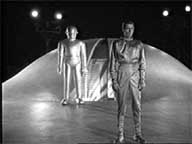
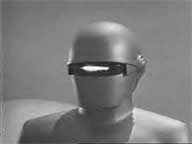 This is Robert Wise's science fiction classic. The story centers around a human-like alien, Klaatu, who travels 25 million miles to talk to the world leaders of Earth about peace. Since the cold war is in full swing, leaders refuse thinking it's the enemy and become hostile. Klaatu, leaves the robot, Gort, to guard his spaceship and goes into hiding by renting a room in a boardinghouse. He learns about humanity by visiting historical site around Washington D.C. and by befriending people from 3 generations, an old scientist, a widowed mother who runs the house, and her young son. Klaatu begins to realize that it's only the world leaders who seem to want war. He leaves Earth with a plea to change our ways or we will be destroyed. Edmund North wrote the very literate script, especially for a sci-fi film, adapting a story by Harry Bates. Bernard Herrmann, as always, provides a great musical score.
This is Robert Wise's science fiction classic. The story centers around a human-like alien, Klaatu, who travels 25 million miles to talk to the world leaders of Earth about peace. Since the cold war is in full swing, leaders refuse thinking it's the enemy and become hostile. Klaatu, leaves the robot, Gort, to guard his spaceship and goes into hiding by renting a room in a boardinghouse. He learns about humanity by visiting historical site around Washington D.C. and by befriending people from 3 generations, an old scientist, a widowed mother who runs the house, and her young son. Klaatu begins to realize that it's only the world leaders who seem to want war. He leaves Earth with a plea to change our ways or we will be destroyed. Edmund North wrote the very literate script, especially for a sci-fi film, adapting a story by Harry Bates. Bernard Herrmann, as always, provides a great musical score.
From Here to Eternity (1953)

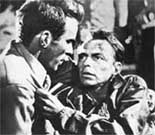 All the studios fought for the rights to this James Jones's novel, even though it was originally considered unfilmable. When this solid adaptation finally appeared in theaters, it became a huge hit and would go on to win 8 Oscars, including Best Picture and Director. The story is set in a U.S. army barracks on Hawaii in 1941, prior to Pearl Harbor. Montgomery Cliff plays a career soldier who resists pressure from a platoon officer who is forcing him to box in a tournament. He ends up falling in love with a prostitute, played by Donna Reed who won an Oscar. Frank Sinatra, another Oscar winner, clashes with tough guy, Ernest Borgnine with deadly consequences. And a sergeant, played by Burt Lancaster begins a torrid affair with his superior officer's wife, Deborah Kerr. All of the stories dealt with clashes of personalities, moral issues, power and authority and would anticipate the rebel figure that would dominate the rest of the 50's. The entire film was filled with great acting and strong direction. This was director Fred Zinnemann's follow-up to "High Noon" (see below) and he didn't miss a beat. The classic scene of Lancaster and Kerr kissing in the surf is one of the most romantic scenes ever filmed. It was considered too erotic for the time, but was uncut from the final print. Appears on the AFI list of best films at #52.
All the studios fought for the rights to this James Jones's novel, even though it was originally considered unfilmable. When this solid adaptation finally appeared in theaters, it became a huge hit and would go on to win 8 Oscars, including Best Picture and Director. The story is set in a U.S. army barracks on Hawaii in 1941, prior to Pearl Harbor. Montgomery Cliff plays a career soldier who resists pressure from a platoon officer who is forcing him to box in a tournament. He ends up falling in love with a prostitute, played by Donna Reed who won an Oscar. Frank Sinatra, another Oscar winner, clashes with tough guy, Ernest Borgnine with deadly consequences. And a sergeant, played by Burt Lancaster begins a torrid affair with his superior officer's wife, Deborah Kerr. All of the stories dealt with clashes of personalities, moral issues, power and authority and would anticipate the rebel figure that would dominate the rest of the 50's. The entire film was filled with great acting and strong direction. This was director Fred Zinnemann's follow-up to "High Noon" (see below) and he didn't miss a beat. The classic scene of Lancaster and Kerr kissing in the surf is one of the most romantic scenes ever filmed. It was considered too erotic for the time, but was uncut from the final print. Appears on the AFI list of best films at #52.
High Noon (1952)

 A classic Western and perhaps Gary Cooper's best role, in a career with many highlights. Cooper plays a frontier marshal who is about to be married to a lovely bride (Grace Kelly shining as only she can). The wedding day is interrupted when rumors about a convict, that the marshal had imprisoned, is free and coming after him. The townspeople, who the marshal has helped for years, desert him and he is left alone to face the outlaws. This wasn't the normal western with Indians and gun fights, but a character study. It shows one man, sticking to his morals and duty when everyone else has abandoned him. Fred Zinnemann's direction was perfect, with many of his shots becoming the new norm for the western. He also held the suspense of the film by shooting the film in real time and showing clocks throughout the picture to heighten the tension. The film is on the Library of Congress National Film Registry and appears of AFI's list of best film at #33.
A classic Western and perhaps Gary Cooper's best role, in a career with many highlights. Cooper plays a frontier marshal who is about to be married to a lovely bride (Grace Kelly shining as only she can). The wedding day is interrupted when rumors about a convict, that the marshal had imprisoned, is free and coming after him. The townspeople, who the marshal has helped for years, desert him and he is left alone to face the outlaws. This wasn't the normal western with Indians and gun fights, but a character study. It shows one man, sticking to his morals and duty when everyone else has abandoned him. Fred Zinnemann's direction was perfect, with many of his shots becoming the new norm for the western. He also held the suspense of the film by shooting the film in real time and showing clocks throughout the picture to heighten the tension. The film is on the Library of Congress National Film Registry and appears of AFI's list of best film at #33.
On the Waterfront (1954)
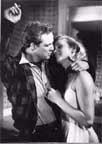
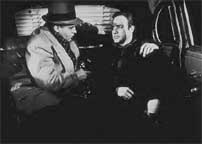 One of those classic Hollywood movies that seems to have developed a myth all of it's own. Marlon Brando stars as Terry Malloy, an ex-boxer who's now a simple dock worker. He begins pursuing and falling in love with Eva Maria Saint, (making her screen debut) a young woman whose brother has been killed by union thugs. Terry's brother, played by Rod Steiger, is a scheming gangster working for the corrupt union. When the criminal acts push Terry too far he decides to go on the stand of the crime commission and squeal on the union. His brother tries to talk him out of it and Brando gives the famous "I could have been a contender" speech. Wondering what his life might have been like if he hadn't given in to crime. Lee J. Cobb, the union leader, makes Terry pay for snitching with a brutal beating, but the martyred figure staggers back to work. The end is a little too much for me and Karl Malden is a little too preachy as the waterfront priest, but it can't overshadow the superior acting from the rest of the cast and the beautiful cinematography of this masterpiece. Much of the movie was filmed on location throughout New York City and it almost becomes a character all its own. Leonard Bernstein composed his first movie score and won an Oscar nomination. The film would go on to win 8 Oscars including Picture, Director (Elia Kazan), Actor (Brando), Supporting Actress (Saint), Story, Art Direction, Editing and Cinematography. Registered as a national treasure with the Library of Congress and appearing on AFI's List of best films at #8.
One of those classic Hollywood movies that seems to have developed a myth all of it's own. Marlon Brando stars as Terry Malloy, an ex-boxer who's now a simple dock worker. He begins pursuing and falling in love with Eva Maria Saint, (making her screen debut) a young woman whose brother has been killed by union thugs. Terry's brother, played by Rod Steiger, is a scheming gangster working for the corrupt union. When the criminal acts push Terry too far he decides to go on the stand of the crime commission and squeal on the union. His brother tries to talk him out of it and Brando gives the famous "I could have been a contender" speech. Wondering what his life might have been like if he hadn't given in to crime. Lee J. Cobb, the union leader, makes Terry pay for snitching with a brutal beating, but the martyred figure staggers back to work. The end is a little too much for me and Karl Malden is a little too preachy as the waterfront priest, but it can't overshadow the superior acting from the rest of the cast and the beautiful cinematography of this masterpiece. Much of the movie was filmed on location throughout New York City and it almost becomes a character all its own. Leonard Bernstein composed his first movie score and won an Oscar nomination. The film would go on to win 8 Oscars including Picture, Director (Elia Kazan), Actor (Brando), Supporting Actress (Saint), Story, Art Direction, Editing and Cinematography. Registered as a national treasure with the Library of Congress and appearing on AFI's List of best films at #8.
The Quiet Man (1952)
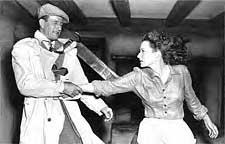
 When making these lists, the first 80% is always easy. It's picking the last few that's the hard part. What to leave on and what to put down on the bottom list. This film was one of four movies vying for the final 2 spots. I was really choosing between this and "Roman Holiday". Both are great romances, contain legendary stars and the location of each is a secondary character. You can really interchange each on this list, but I finally choose "The Quiet Man". The director John Ford and star John Wayne had teamed with each other many times before, all for Westerns, but this film was a huge change for both. Set in County Galway, Ireland, the birthplace of the director's parents, it tells of an American boxer (John Wayne) disillusioned with himself after he accidentally kills an opponent in the ring. He moves back to Ireland, the place of his birth and falls in love with the free-spirited, red-haired Mary Kate Danaher (Maureen O'Hara). It becomes somewhat of an Irish "Taming of the Shrew". They finally get married, but Kate's brother is against the whole marriage and this leads to one of the longest fight sequences in film. The stars and supporting actors are all wonderful. The movie is one of the most beautifully filmed with lush colors everywhere. (In fact if anyone has a good color photograph of the film that I can borrow, I would appreciate it!) It won an Oscar for it's cinematography and Ford, the director.
When making these lists, the first 80% is always easy. It's picking the last few that's the hard part. What to leave on and what to put down on the bottom list. This film was one of four movies vying for the final 2 spots. I was really choosing between this and "Roman Holiday". Both are great romances, contain legendary stars and the location of each is a secondary character. You can really interchange each on this list, but I finally choose "The Quiet Man". The director John Ford and star John Wayne had teamed with each other many times before, all for Westerns, but this film was a huge change for both. Set in County Galway, Ireland, the birthplace of the director's parents, it tells of an American boxer (John Wayne) disillusioned with himself after he accidentally kills an opponent in the ring. He moves back to Ireland, the place of his birth and falls in love with the free-spirited, red-haired Mary Kate Danaher (Maureen O'Hara). It becomes somewhat of an Irish "Taming of the Shrew". They finally get married, but Kate's brother is against the whole marriage and this leads to one of the longest fight sequences in film. The stars and supporting actors are all wonderful. The movie is one of the most beautifully filmed with lush colors everywhere. (In fact if anyone has a good color photograph of the film that I can borrow, I would appreciate it!) It won an Oscar for it's cinematography and Ford, the director.
Rear Window (1954)
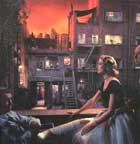
 One of my favorite Alfred Hitchcock films (which is saying a lot because I love them all). It stars two of mine and Hitchcock's favorite actors in Jimmy Stewart and Grace Kelly. Stewart plays L.B. Jefferies, a world class photographer who is stuck in his room due to a supposed, work related, broken leg. With nothing else to do, he begins to observe (spy on) his neighbors across his apartment courtyard through his telephoto camera lens. His girlfriend, played by Kelly in one of the most radiating roles ever filmed, is a fashion model who's trying everything to get a commitment from Jefferies. Through his daily observations, he begins to suspect that one of his neighbors (Raymond Burr) may have murdered his wife. He convinces both Kelly and his nurse (played wonderfully by Thelma Ritter) and together they begin to collect clues to the mystery. When the killer realizes he's being watched, he comes after Jefferies who has no where to escape while being stuck in his wheelchair. Hitchcock filled this film with great suspense like only he could. It became somewhat of an experimental film being shot from just the interior of Jeffries apartment (except for one exterior shot), but it never becomes boring. Even the soundtrack was different with all the music coming from the neighbor's radios or the piano player living next door. The film has been analyzed for it's voyeuristic themes similar to that of the movie going audience, which is rather interesting, but can be enjoyed without thinking about it that hard. Appears on the AFI list of best films at #42.
One of my favorite Alfred Hitchcock films (which is saying a lot because I love them all). It stars two of mine and Hitchcock's favorite actors in Jimmy Stewart and Grace Kelly. Stewart plays L.B. Jefferies, a world class photographer who is stuck in his room due to a supposed, work related, broken leg. With nothing else to do, he begins to observe (spy on) his neighbors across his apartment courtyard through his telephoto camera lens. His girlfriend, played by Kelly in one of the most radiating roles ever filmed, is a fashion model who's trying everything to get a commitment from Jefferies. Through his daily observations, he begins to suspect that one of his neighbors (Raymond Burr) may have murdered his wife. He convinces both Kelly and his nurse (played wonderfully by Thelma Ritter) and together they begin to collect clues to the mystery. When the killer realizes he's being watched, he comes after Jefferies who has no where to escape while being stuck in his wheelchair. Hitchcock filled this film with great suspense like only he could. It became somewhat of an experimental film being shot from just the interior of Jeffries apartment (except for one exterior shot), but it never becomes boring. Even the soundtrack was different with all the music coming from the neighbor's radios or the piano player living next door. The film has been analyzed for it's voyeuristic themes similar to that of the movie going audience, which is rather interesting, but can be enjoyed without thinking about it that hard. Appears on the AFI list of best films at #42.
Seven Brides for Seven Brothers (1954)
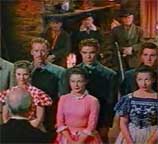 The story of this film is kind of silly, but I guess so is the plot for most musicals. A woodsman (Howard Keel) and woman (Jane Powell) fall in love and get married. His six brothers become jealous and go off to kidnap six women of their own, bringing them back to their cabin on top of a hill. A huge snowstorm hits causing the boyfriends and fathers to have to wait for spring to help rescue them. Of course, over the winter the six women fall in love with the brothers which leads to a huge wedding. Stanley Donen directs and integrates the music, amazing dances and story perfectly together, each helping to tell the story.
The story of this film is kind of silly, but I guess so is the plot for most musicals. A woodsman (Howard Keel) and woman (Jane Powell) fall in love and get married. His six brothers become jealous and go off to kidnap six women of their own, bringing them back to their cabin on top of a hill. A huge snowstorm hits causing the boyfriends and fathers to have to wait for spring to help rescue them. Of course, over the winter the six women fall in love with the brothers which leads to a huge wedding. Stanley Donen directs and integrates the music, amazing dances and story perfectly together, each helping to tell the story.
Shane (1953)
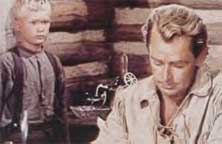 One of the best Westerns ever made. Alan Ladd stars as Shane, the drifting stranger who comes upon a young, farming family that is being hassled by cattle ranchers. The cattle Barons want the land, but Shane, who happens to be a gunslinger, helps the family fight them off. In doing so, he becomes a father figure to the young son (Brandon de Wilde) and a love object to the wife (Jean Arthur in her last film). By the end of the movie, Shane rides off into the sunset, alone, as the boy screams out his name in the distance. Jack Palance is at his best as the creepy, evil, hired killer, especially as he grins and slowly puts on his black leather gloves right before his is to kill someone. The plot seems very familiar, maybe because the lone stranger was copied so often from here on out, especially in the Clint Eastwood westerns, but it is handled with dignity by director George Stevens. The breathtaking scenery helped Loyal Griggs win the Oscar for cinematography. If you wanted to understand the American Western as mythology, this may be the best film to view. Listed on AFI's list of best films at #69.
One of the best Westerns ever made. Alan Ladd stars as Shane, the drifting stranger who comes upon a young, farming family that is being hassled by cattle ranchers. The cattle Barons want the land, but Shane, who happens to be a gunslinger, helps the family fight them off. In doing so, he becomes a father figure to the young son (Brandon de Wilde) and a love object to the wife (Jean Arthur in her last film). By the end of the movie, Shane rides off into the sunset, alone, as the boy screams out his name in the distance. Jack Palance is at his best as the creepy, evil, hired killer, especially as he grins and slowly puts on his black leather gloves right before his is to kill someone. The plot seems very familiar, maybe because the lone stranger was copied so often from here on out, especially in the Clint Eastwood westerns, but it is handled with dignity by director George Stevens. The breathtaking scenery helped Loyal Griggs win the Oscar for cinematography. If you wanted to understand the American Western as mythology, this may be the best film to view. Listed on AFI's list of best films at #69.
Singin In the Rain (1952)
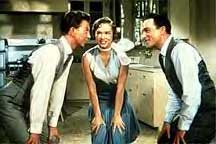
 This film contains some very corny songs including, "You Were Meant For Me" and "Calendar Girl" as well as the simple plot of boy meets girl, boy loses girl and boy wins girl back. But with that out of the way, this truly is one of the top ten films of all time, it is that PREFECT! It may be the best musical, one of the funniest comedies, and a great movie that takes a look at how early films were made and the transition from silent films to talkies. The film begins at a Hollywood movie opening. The silent screen stars of the opening, Don Lockwood and Lina Lamont, (played wonderfully by Gene Kelly and Jean Hagan) tell the gossip columnist how they started in the biz. The flashback scenes show Lockwood and his long time friend, Cosmo Brown (Donald O'Connor), starting in vaudeville and their slow rise through the ranks to that of stuntman and musician. At the after hours party, the head of the studio tells the guests about the crazy new invention of talking movies, which he believes will never sell. Of course we know this isn't the case, and the studio begins switching over to talkies. Lockwood and Lamont try to change with the times, but Lina has a voice that sounds like nails on a chalkboard. Don's new girlfriend, Kathy Shelden (played by Debbie Reynolds in her first role) dubs in the voice for Lina without her knowing. This causes a big commotion until the end when everything turns out just right. The film is filled with wonderful song and dance numbers including, "Moses", "Good Morning", "Broadway Rhythm" and the title song "Singin In the Rain". The last being the best and most joyous musical sequence on film. As Kelly literally sings and splashes around in the rain. Another classic sequence has O'Connor singing and flipping around walls in "Make' Em Laugh". All the characters, from leads to supporting roles are perfectly cast. The only thing I would change about the film is the song "Calendar Girl". It just seems like a filler song, sung by a non-character, with no plot purpose what-so-ever. This film is one of my all time favorites, is registered with the Library of Congress as a national treasure, and appears on the AFI list of best films at #10.
This film contains some very corny songs including, "You Were Meant For Me" and "Calendar Girl" as well as the simple plot of boy meets girl, boy loses girl and boy wins girl back. But with that out of the way, this truly is one of the top ten films of all time, it is that PREFECT! It may be the best musical, one of the funniest comedies, and a great movie that takes a look at how early films were made and the transition from silent films to talkies. The film begins at a Hollywood movie opening. The silent screen stars of the opening, Don Lockwood and Lina Lamont, (played wonderfully by Gene Kelly and Jean Hagan) tell the gossip columnist how they started in the biz. The flashback scenes show Lockwood and his long time friend, Cosmo Brown (Donald O'Connor), starting in vaudeville and their slow rise through the ranks to that of stuntman and musician. At the after hours party, the head of the studio tells the guests about the crazy new invention of talking movies, which he believes will never sell. Of course we know this isn't the case, and the studio begins switching over to talkies. Lockwood and Lamont try to change with the times, but Lina has a voice that sounds like nails on a chalkboard. Don's new girlfriend, Kathy Shelden (played by Debbie Reynolds in her first role) dubs in the voice for Lina without her knowing. This causes a big commotion until the end when everything turns out just right. The film is filled with wonderful song and dance numbers including, "Moses", "Good Morning", "Broadway Rhythm" and the title song "Singin In the Rain". The last being the best and most joyous musical sequence on film. As Kelly literally sings and splashes around in the rain. Another classic sequence has O'Connor singing and flipping around walls in "Make' Em Laugh". All the characters, from leads to supporting roles are perfectly cast. The only thing I would change about the film is the song "Calendar Girl". It just seems like a filler song, sung by a non-character, with no plot purpose what-so-ever. This film is one of my all time favorites, is registered with the Library of Congress as a national treasure, and appears on the AFI list of best films at #10.
A Streetcar Named Desire (1951)
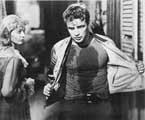 The only really successful screen adaptation of a Tennessee Williams play mainly because of the brilliant acting by absolutely everyone. A fragile young woman, Blanche Dubois, arrives in New Orleans to stay with her younger sister, Stella and her abusive husband Stanley Kowalski. Blanche is hanging on the brink of insanity, but instead of helping, Stanley takes advantage of her weak state and ends up destroying her instead. Vivian Leigh, playing Blanche, Kim Hunter, playing Stella and Karl Malden as a suitor of Blanche all won Oscars, but it was Marlon Brando portrayal of Stanley that was most memorable. Appears on the AFI list of best films at #45.
The only really successful screen adaptation of a Tennessee Williams play mainly because of the brilliant acting by absolutely everyone. A fragile young woman, Blanche Dubois, arrives in New Orleans to stay with her younger sister, Stella and her abusive husband Stanley Kowalski. Blanche is hanging on the brink of insanity, but instead of helping, Stanley takes advantage of her weak state and ends up destroying her instead. Vivian Leigh, playing Blanche, Kim Hunter, playing Stella and Karl Malden as a suitor of Blanche all won Oscars, but it was Marlon Brando portrayal of Stanley that was most memorable. Appears on the AFI list of best films at #45.
Sunset Boulevard (1950)

 You know this movie is gonna be cool when you realize that the voiceover for the film is being given by the dead guy floating in the pool. The man dead is Joe Gillis (William Holden) a screenwriter, who begins to tell how he fell to his demise. Having no money, and fleeing from finance men, Joe mistakenly pulls into the mansion of Norma Desmond, a once great silent movie star. Hoping to make some money, he agrees to rewrite a script that Desmond believes will be her comeback film. Norma's butler, Max, who we later find out is her husband, moves all Joe's belongings into the mansion. They begin having a strange love affair as they each use each other for their own benefits. When Norma ruins a relationship Joe is having with a young woman, he threatens to move out and she in returns pulls out a gun. The film is littered with glimpses of old time Hollywood, the gothic horror films, elegant romances and film-noir. But it's really Gloria Swanson, played Norma, that makes this film special. An actual silent screen star, she gives one of the best sound era roles in film history. The movie contains many classic scenes and lines including "I am big, it's the pictures that got small." and the great closing scene of Norma walking down the staircase, telling Cecil B DeMille that she's ready for her close-up. Appears on AFI's list of best films at #12.
You know this movie is gonna be cool when you realize that the voiceover for the film is being given by the dead guy floating in the pool. The man dead is Joe Gillis (William Holden) a screenwriter, who begins to tell how he fell to his demise. Having no money, and fleeing from finance men, Joe mistakenly pulls into the mansion of Norma Desmond, a once great silent movie star. Hoping to make some money, he agrees to rewrite a script that Desmond believes will be her comeback film. Norma's butler, Max, who we later find out is her husband, moves all Joe's belongings into the mansion. They begin having a strange love affair as they each use each other for their own benefits. When Norma ruins a relationship Joe is having with a young woman, he threatens to move out and she in returns pulls out a gun. The film is littered with glimpses of old time Hollywood, the gothic horror films, elegant romances and film-noir. But it's really Gloria Swanson, played Norma, that makes this film special. An actual silent screen star, she gives one of the best sound era roles in film history. The movie contains many classic scenes and lines including "I am big, it's the pictures that got small." and the great closing scene of Norma walking down the staircase, telling Cecil B DeMille that she's ready for her close-up. Appears on AFI's list of best films at #12.
The Thing (From Another World) (1951)

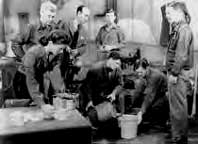 This was the last film I placed on my list. It was between this film and Hitchcock's "Stranger on a Train". "Stranger" is the better made of the two films and contains great suspense, but I have quite a few Hitchcock films throughout my lists and decided to give someone else a chance. Based on John W. Campbell's story "Who Goes There?". A frozen alien is accidentally thawed out at an army radar station in the Arctic and the entire crew must now fight for their lives while being trapped at the station. This is one of those classic films that relies on the unseen rather than the seen for its suspense and scares. An audience's mind will always play more tricks and create more frightful situations than can be shown with a camera. Howard Hawks, who produced the film is credited with helping create the tight direction and pacing throughout the movie. The entire cast, of no real stars, all do a fine job, and the eerie score by Dimitri Tiomkin contributes to the suspense. The film was remade by John Carpenter in 1982 using gruesome special effects, and was the inspiration for the "Alien" franchise as well as many horror and sci-fi movies.
This was the last film I placed on my list. It was between this film and Hitchcock's "Stranger on a Train". "Stranger" is the better made of the two films and contains great suspense, but I have quite a few Hitchcock films throughout my lists and decided to give someone else a chance. Based on John W. Campbell's story "Who Goes There?". A frozen alien is accidentally thawed out at an army radar station in the Arctic and the entire crew must now fight for their lives while being trapped at the station. This is one of those classic films that relies on the unseen rather than the seen for its suspense and scares. An audience's mind will always play more tricks and create more frightful situations than can be shown with a camera. Howard Hawks, who produced the film is credited with helping create the tight direction and pacing throughout the movie. The entire cast, of no real stars, all do a fine job, and the eerie score by Dimitri Tiomkin contributes to the suspense. The film was remade by John Carpenter in 1982 using gruesome special effects, and was the inspiration for the "Alien" franchise as well as many horror and sci-fi movies.
Honorable Mention
An American In Paris (1951)

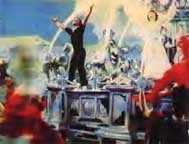 I put this film as an honorable mention because I believe there are a few too many flaws in the movie to have it appear on the "best of list" and quite frankly it bores me in parts, but the film contains such a wonderful and joyous 18 minutes, that is should be recognized. Gene Kelly, rightly received an honorary Oscar for his wonderful dancing and choreography of George Gershwin's "An American In Paris". The vibrate, colorful and exciting 18 minute ballet that ends this film is one of the best dance sequences ever filmed. Appears on the AFI list of best films at #68.
I put this film as an honorable mention because I believe there are a few too many flaws in the movie to have it appear on the "best of list" and quite frankly it bores me in parts, but the film contains such a wonderful and joyous 18 minutes, that is should be recognized. Gene Kelly, rightly received an honorary Oscar for his wonderful dancing and choreography of George Gershwin's "An American In Paris". The vibrate, colorful and exciting 18 minute ballet that ends this film is one of the best dance sequences ever filmed. Appears on the AFI list of best films at #68.
Great Moments from early 50's Movies
These are those special moments from the movies that once you see them you will never forget them. The rest of the movie might not stay with you, but these shots or sequences are now emblazed in your psyche. It may be a special effect, or an actor or actress, or the cinematography, but these are the moments that movies were made for!
Riding In A Pumpkin (50): Disney draws another classic animated film with "Cinderella."
Marrying Off Your Daughter (50): Spencer Tracy is the perfect "Father of the Bride" as he watches his baby girl (Elizabeth Taylor) get married.
The Happiness of a Six Foot Rabbit (50): Jimmy Stewart tells of his invisible rabbit named "Harvey."
Indiana Jones Would Be Proud (50): Stewart Granger and Deborah Kerr help search for "King Solomon's Mines."
Looking For Your Own Killer (50): Edmund O'Brien, slowly dieing from radiation poisoning searches for his killer in "D.O.A."
Beauty and Romance In Slow Motion (51): The amazing beauty of Elizabeth Taylor in her slow motion kiss with Montgomery Clift in "A Place In the Sun."
A News Tabloid On Film (52): Kirk Douglas exposes Hollywood as an over ambitious moviemaker in "The Bad and the Beautiful."
Dying To Be A Model (53): Vincent Price gives his wonderful portrayal of evil in "A House of Wax."
What A Wonderful Vacation (53): Audrey Hepburn shines as a princess in disguise with Gregory Peck in a "Roman Holiday."
The Aliens Strike Again (53): The classic H.G. Wells story, "War of the Worlds" gets adapted to the screen with wonderful special effects.
A Big Film For A Big Subject (53): The first film made in the new widescreen cinemascope told of "The Robe" of Christ.
"Diamonds Are A Girl's Best Friend" (53): Marilyn Manroe sang one of her classic songs in "How to Marry A Millionaire."
The Look Of Leather (53): Marlon Brando riding a motorcycle and decked out in black leather in "The Wild Ones."
An Ugly Duckling? Yeah Right! (54): An ugly duckling, played by Audrey Hepburn leaves for Paris and comes back as the beauty that she is, stealing the hearts of Humphrey Bogart and William Holden in "Sabrina."
The Giant Squid Fights Back (54): The enchanted adventure of Disney's "20,000 Leagues Under the Sea."
When You Really Need A Roach Motel (54): The scary and fun, giant "B" movie ants from "Them".
All Hail the Fish Man (54): The "Creature From the Black Lagoon" is still one of the best looking monsters ever created for the silver screen.
| |
|
|
Back to the Top
To the MOVIES Homepage


 If anything, this film paired two of the all-time legends of Hollywood, Humphrey Bogart and Katharine Hepburn. The story centers around Rose, a spinsterish missionary who becomes stranded at her East African Mission when the Germans attack during WWI. She is reluctantly picked up by Charlie, a boozing, tugboat captain and they flee downriver on the rickety boat named "African Queen". Their personalities immediately begin to clash, but the dangerous adventure begins to pulls them closer and closer. They encounter leeches, swarms of insects, water rapids, being fired upon and dead ends which all leaves to Rose and Charlie falling in love. They end up becoming one of the cinema's most touching and romantic couples. By the end of the film, they decide to try and blow up a German battleship. The film would go on to influence other movies, including the 80's "Romancing the Stone" as well as inspire Walt Disney to develop the Jungle Cruise ride for Disneyland. Appears on AFI's list of best films at #17.
If anything, this film paired two of the all-time legends of Hollywood, Humphrey Bogart and Katharine Hepburn. The story centers around Rose, a spinsterish missionary who becomes stranded at her East African Mission when the Germans attack during WWI. She is reluctantly picked up by Charlie, a boozing, tugboat captain and they flee downriver on the rickety boat named "African Queen". Their personalities immediately begin to clash, but the dangerous adventure begins to pulls them closer and closer. They encounter leeches, swarms of insects, water rapids, being fired upon and dead ends which all leaves to Rose and Charlie falling in love. They end up becoming one of the cinema's most touching and romantic couples. By the end of the film, they decide to try and blow up a German battleship. The film would go on to influence other movies, including the 80's "Romancing the Stone" as well as inspire Walt Disney to develop the Jungle Cruise ride for Disneyland. Appears on AFI's list of best films at #17.
 A true classic that helped restart the career of a Hollywood legend. Bette Davis, in one of her best roles, plays Margo Channing, an aging actress of the stage. Eve Harrington, a young "fan" played by Anne Baxter, comes to see Davis every night and finally gets to meet her idol one evening after the performance. The older actress is somewhat fond of the young woman and begins mentoring her. Little does she know that the woman has her own plans of replacing Davis. The films supporting cast is topnotch. Gary Merrill plays Margo's loyal husband. Hugh Marlowe is the playwright who succumbs to Eve's charm and George Sanders is Addison Dewitt, the theater critic who finally outsmarts the calculating young star. The film was also an early screen appearance for Marilyn Monroe. Containing some of the sharpest dialogue ever written for a film, including such classic lines as, "Fasten you seatbelts, it's gonna be a bumpy night!", it was nominated for 12 Academy Awards and winning 6 including Best Picture and screenplay. Both Davis and Baxter were nominated for Best Actress in a very strong year for women, including Gloria Swanson of "Sunset Boulevard" and the winner Judy Holliday of "Born Yesterday". Appears on AFI's list of best films at #16.
A true classic that helped restart the career of a Hollywood legend. Bette Davis, in one of her best roles, plays Margo Channing, an aging actress of the stage. Eve Harrington, a young "fan" played by Anne Baxter, comes to see Davis every night and finally gets to meet her idol one evening after the performance. The older actress is somewhat fond of the young woman and begins mentoring her. Little does she know that the woman has her own plans of replacing Davis. The films supporting cast is topnotch. Gary Merrill plays Margo's loyal husband. Hugh Marlowe is the playwright who succumbs to Eve's charm and George Sanders is Addison Dewitt, the theater critic who finally outsmarts the calculating young star. The film was also an early screen appearance for Marilyn Monroe. Containing some of the sharpest dialogue ever written for a film, including such classic lines as, "Fasten you seatbelts, it's gonna be a bumpy night!", it was nominated for 12 Academy Awards and winning 6 including Best Picture and screenplay. Both Davis and Baxter were nominated for Best Actress in a very strong year for women, including Gloria Swanson of "Sunset Boulevard" and the winner Judy Holliday of "Born Yesterday". Appears on AFI's list of best films at #16. This has always been one of my favorite stories. I can't get through the Holidays without watching a few versions of Dickens classic tale. I have no idea how many interpretations exist right now. There seems to be 2 or 3 new variations every year, but this rendition is one of the most faithful to Dickens original. Most know the story of the old miser, Ebenezer Scrooge who is visited by his dead partner Jacob Marley and told to change his ways. To help Scrooge along the way, he is visited by the ghosts of Christmas past, present and future in the hopes of making him a better person. One of the reasons this version seems to shine above others is the great performance of Alastair Sim in the title role. He shines on the screen and seems to truly transforms from the mean old penny pincher to a joyful and caring human being. The screenplay was by Noel Langley, who co-penned "The Wizard of Oz" and the style is evident. Other versions of note are "Scrooge", a 1970 British musical version, "Mickey's Christmas Carol", a Disney version, and a 1984 version starring George C. Scott.
This has always been one of my favorite stories. I can't get through the Holidays without watching a few versions of Dickens classic tale. I have no idea how many interpretations exist right now. There seems to be 2 or 3 new variations every year, but this rendition is one of the most faithful to Dickens original. Most know the story of the old miser, Ebenezer Scrooge who is visited by his dead partner Jacob Marley and told to change his ways. To help Scrooge along the way, he is visited by the ghosts of Christmas past, present and future in the hopes of making him a better person. One of the reasons this version seems to shine above others is the great performance of Alastair Sim in the title role. He shines on the screen and seems to truly transforms from the mean old penny pincher to a joyful and caring human being. The screenplay was by Noel Langley, who co-penned "The Wizard of Oz" and the style is evident. Other versions of note are "Scrooge", a 1970 British musical version, "Mickey's Christmas Carol", a Disney version, and a 1984 version starring George C. Scott.
 This is Robert Wise's science fiction classic. The story centers around a human-like alien, Klaatu, who travels 25 million miles to talk to the world leaders of Earth about peace. Since the cold war is in full swing, leaders refuse thinking it's the enemy and become hostile. Klaatu, leaves the robot, Gort, to guard his spaceship and goes into hiding by renting a room in a boardinghouse. He learns about humanity by visiting historical site around Washington D.C. and by befriending people from 3 generations, an old scientist, a widowed mother who runs the house, and her young son. Klaatu begins to realize that it's only the world leaders who seem to want war. He leaves Earth with a plea to change our ways or we will be destroyed. Edmund North wrote the very literate script, especially for a sci-fi film, adapting a story by Harry Bates. Bernard Herrmann, as always, provides a great musical score.
This is Robert Wise's science fiction classic. The story centers around a human-like alien, Klaatu, who travels 25 million miles to talk to the world leaders of Earth about peace. Since the cold war is in full swing, leaders refuse thinking it's the enemy and become hostile. Klaatu, leaves the robot, Gort, to guard his spaceship and goes into hiding by renting a room in a boardinghouse. He learns about humanity by visiting historical site around Washington D.C. and by befriending people from 3 generations, an old scientist, a widowed mother who runs the house, and her young son. Klaatu begins to realize that it's only the world leaders who seem to want war. He leaves Earth with a plea to change our ways or we will be destroyed. Edmund North wrote the very literate script, especially for a sci-fi film, adapting a story by Harry Bates. Bernard Herrmann, as always, provides a great musical score. 
 All the studios fought for the rights to this James Jones's novel, even though it was originally considered unfilmable. When this solid adaptation finally appeared in theaters, it became a huge hit and would go on to win 8 Oscars, including Best Picture and Director. The story is set in a U.S. army barracks on Hawaii in 1941, prior to Pearl Harbor. Montgomery Cliff plays a career soldier who resists pressure from a platoon officer who is forcing him to box in a tournament. He ends up falling in love with a prostitute, played by Donna Reed who won an Oscar. Frank Sinatra, another Oscar winner, clashes with tough guy, Ernest Borgnine with deadly consequences. And a sergeant, played by Burt Lancaster begins a torrid affair with his superior officer's wife, Deborah Kerr. All of the stories dealt with clashes of personalities, moral issues, power and authority and would anticipate the rebel figure that would dominate the rest of the 50's. The entire film was filled with great acting and strong direction. This was director Fred Zinnemann's follow-up to "High Noon" (see below) and he didn't miss a beat. The classic scene of Lancaster and Kerr kissing in the surf is one of the most romantic scenes ever filmed. It was considered too erotic for the time, but was uncut from the final print. Appears on the AFI list of best films at #52.
All the studios fought for the rights to this James Jones's novel, even though it was originally considered unfilmable. When this solid adaptation finally appeared in theaters, it became a huge hit and would go on to win 8 Oscars, including Best Picture and Director. The story is set in a U.S. army barracks on Hawaii in 1941, prior to Pearl Harbor. Montgomery Cliff plays a career soldier who resists pressure from a platoon officer who is forcing him to box in a tournament. He ends up falling in love with a prostitute, played by Donna Reed who won an Oscar. Frank Sinatra, another Oscar winner, clashes with tough guy, Ernest Borgnine with deadly consequences. And a sergeant, played by Burt Lancaster begins a torrid affair with his superior officer's wife, Deborah Kerr. All of the stories dealt with clashes of personalities, moral issues, power and authority and would anticipate the rebel figure that would dominate the rest of the 50's. The entire film was filled with great acting and strong direction. This was director Fred Zinnemann's follow-up to "High Noon" (see below) and he didn't miss a beat. The classic scene of Lancaster and Kerr kissing in the surf is one of the most romantic scenes ever filmed. It was considered too erotic for the time, but was uncut from the final print. Appears on the AFI list of best films at #52. 
 A classic Western and perhaps Gary Cooper's best role, in a career with many highlights. Cooper plays a frontier marshal who is about to be married to a lovely bride (Grace Kelly shining as only she can). The wedding day is interrupted when rumors about a convict, that the marshal had imprisoned, is free and coming after him. The townspeople, who the marshal has helped for years, desert him and he is left alone to face the outlaws. This wasn't the normal western with Indians and gun fights, but a character study. It shows one man, sticking to his morals and duty when everyone else has abandoned him. Fred Zinnemann's direction was perfect, with many of his shots becoming the new norm for the western. He also held the suspense of the film by shooting the film in real time and showing clocks throughout the picture to heighten the tension. The film is on the Library of Congress National Film Registry and appears of AFI's list of best film at #33.
A classic Western and perhaps Gary Cooper's best role, in a career with many highlights. Cooper plays a frontier marshal who is about to be married to a lovely bride (Grace Kelly shining as only she can). The wedding day is interrupted when rumors about a convict, that the marshal had imprisoned, is free and coming after him. The townspeople, who the marshal has helped for years, desert him and he is left alone to face the outlaws. This wasn't the normal western with Indians and gun fights, but a character study. It shows one man, sticking to his morals and duty when everyone else has abandoned him. Fred Zinnemann's direction was perfect, with many of his shots becoming the new norm for the western. He also held the suspense of the film by shooting the film in real time and showing clocks throughout the picture to heighten the tension. The film is on the Library of Congress National Film Registry and appears of AFI's list of best film at #33.
 One of those classic Hollywood movies that seems to have developed a myth all of it's own. Marlon Brando stars as Terry Malloy, an ex-boxer who's now a simple dock worker. He begins pursuing and falling in love with Eva Maria Saint, (making her screen debut) a young woman whose brother has been killed by union thugs. Terry's brother, played by Rod Steiger, is a scheming gangster working for the corrupt union. When the criminal acts push Terry too far he decides to go on the stand of the crime commission and squeal on the union. His brother tries to talk him out of it and Brando gives the famous "I could have been a contender" speech. Wondering what his life might have been like if he hadn't given in to crime. Lee J. Cobb, the union leader, makes Terry pay for snitching with a brutal beating, but the martyred figure staggers back to work. The end is a little too much for me and Karl Malden is a little too preachy as the waterfront priest, but it can't overshadow the superior acting from the rest of the cast and the beautiful cinematography of this masterpiece. Much of the movie was filmed on location throughout New York City and it almost becomes a character all its own. Leonard Bernstein composed his first movie score and won an Oscar nomination. The film would go on to win 8 Oscars including Picture, Director (Elia Kazan), Actor (Brando), Supporting Actress (Saint), Story, Art Direction, Editing and Cinematography. Registered as a national treasure with the Library of Congress and appearing on AFI's List of best films at #8.
One of those classic Hollywood movies that seems to have developed a myth all of it's own. Marlon Brando stars as Terry Malloy, an ex-boxer who's now a simple dock worker. He begins pursuing and falling in love with Eva Maria Saint, (making her screen debut) a young woman whose brother has been killed by union thugs. Terry's brother, played by Rod Steiger, is a scheming gangster working for the corrupt union. When the criminal acts push Terry too far he decides to go on the stand of the crime commission and squeal on the union. His brother tries to talk him out of it and Brando gives the famous "I could have been a contender" speech. Wondering what his life might have been like if he hadn't given in to crime. Lee J. Cobb, the union leader, makes Terry pay for snitching with a brutal beating, but the martyred figure staggers back to work. The end is a little too much for me and Karl Malden is a little too preachy as the waterfront priest, but it can't overshadow the superior acting from the rest of the cast and the beautiful cinematography of this masterpiece. Much of the movie was filmed on location throughout New York City and it almost becomes a character all its own. Leonard Bernstein composed his first movie score and won an Oscar nomination. The film would go on to win 8 Oscars including Picture, Director (Elia Kazan), Actor (Brando), Supporting Actress (Saint), Story, Art Direction, Editing and Cinematography. Registered as a national treasure with the Library of Congress and appearing on AFI's List of best films at #8.
 When making these lists, the first 80% is always easy. It's picking the last few that's the hard part. What to leave on and what to put down on the bottom list. This film was one of four movies vying for the final 2 spots. I was really choosing between this and "Roman Holiday". Both are great romances, contain legendary stars and the location of each is a secondary character. You can really interchange each on this list, but I finally choose "The Quiet Man". The director John Ford and star John Wayne had teamed with each other many times before, all for Westerns, but this film was a huge change for both. Set in County Galway, Ireland, the birthplace of the director's parents, it tells of an American boxer (John Wayne) disillusioned with himself after he accidentally kills an opponent in the ring. He moves back to Ireland, the place of his birth and falls in love with the free-spirited, red-haired Mary Kate Danaher (Maureen O'Hara). It becomes somewhat of an Irish "Taming of the Shrew". They finally get married, but Kate's brother is against the whole marriage and this leads to one of the longest fight sequences in film. The stars and supporting actors are all wonderful. The movie is one of the most beautifully filmed with lush colors everywhere. (In fact if anyone has a good color photograph of the film that I can borrow, I would appreciate it!) It won an Oscar for it's cinematography and Ford, the director.
When making these lists, the first 80% is always easy. It's picking the last few that's the hard part. What to leave on and what to put down on the bottom list. This film was one of four movies vying for the final 2 spots. I was really choosing between this and "Roman Holiday". Both are great romances, contain legendary stars and the location of each is a secondary character. You can really interchange each on this list, but I finally choose "The Quiet Man". The director John Ford and star John Wayne had teamed with each other many times before, all for Westerns, but this film was a huge change for both. Set in County Galway, Ireland, the birthplace of the director's parents, it tells of an American boxer (John Wayne) disillusioned with himself after he accidentally kills an opponent in the ring. He moves back to Ireland, the place of his birth and falls in love with the free-spirited, red-haired Mary Kate Danaher (Maureen O'Hara). It becomes somewhat of an Irish "Taming of the Shrew". They finally get married, but Kate's brother is against the whole marriage and this leads to one of the longest fight sequences in film. The stars and supporting actors are all wonderful. The movie is one of the most beautifully filmed with lush colors everywhere. (In fact if anyone has a good color photograph of the film that I can borrow, I would appreciate it!) It won an Oscar for it's cinematography and Ford, the director.

 One of my favorite Alfred Hitchcock films (which is saying a lot because I love them all). It stars two of mine and Hitchcock's favorite actors in Jimmy Stewart and Grace Kelly. Stewart plays L.B. Jefferies, a world class photographer who is stuck in his room due to a supposed, work related, broken leg. With nothing else to do, he begins to observe (spy on) his neighbors across his apartment courtyard through his telephoto camera lens. His girlfriend, played by Kelly in one of the most radiating roles ever filmed, is a fashion model who's trying everything to get a commitment from Jefferies. Through his daily observations, he begins to suspect that one of his neighbors (Raymond Burr) may have murdered his wife. He convinces both Kelly and his nurse (played wonderfully by Thelma Ritter) and together they begin to collect clues to the mystery. When the killer realizes he's being watched, he comes after Jefferies who has no where to escape while being stuck in his wheelchair. Hitchcock filled this film with great suspense like only he could. It became somewhat of an experimental film being shot from just the interior of Jeffries apartment (except for one exterior shot), but it never becomes boring. Even the soundtrack was different with all the music coming from the neighbor's radios or the piano player living next door. The film has been analyzed for it's voyeuristic themes similar to that of the movie going audience, which is rather interesting, but can be enjoyed without thinking about it that hard. Appears on the AFI list of best films at #42.
One of my favorite Alfred Hitchcock films (which is saying a lot because I love them all). It stars two of mine and Hitchcock's favorite actors in Jimmy Stewart and Grace Kelly. Stewart plays L.B. Jefferies, a world class photographer who is stuck in his room due to a supposed, work related, broken leg. With nothing else to do, he begins to observe (spy on) his neighbors across his apartment courtyard through his telephoto camera lens. His girlfriend, played by Kelly in one of the most radiating roles ever filmed, is a fashion model who's trying everything to get a commitment from Jefferies. Through his daily observations, he begins to suspect that one of his neighbors (Raymond Burr) may have murdered his wife. He convinces both Kelly and his nurse (played wonderfully by Thelma Ritter) and together they begin to collect clues to the mystery. When the killer realizes he's being watched, he comes after Jefferies who has no where to escape while being stuck in his wheelchair. Hitchcock filled this film with great suspense like only he could. It became somewhat of an experimental film being shot from just the interior of Jeffries apartment (except for one exterior shot), but it never becomes boring. Even the soundtrack was different with all the music coming from the neighbor's radios or the piano player living next door. The film has been analyzed for it's voyeuristic themes similar to that of the movie going audience, which is rather interesting, but can be enjoyed without thinking about it that hard. Appears on the AFI list of best films at #42.
 The story of this film is kind of silly, but I guess so is the plot for most musicals. A woodsman (Howard Keel) and woman (Jane Powell) fall in love and get married. His six brothers become jealous and go off to kidnap six women of their own, bringing them back to their cabin on top of a hill. A huge snowstorm hits causing the boyfriends and fathers to have to wait for spring to help rescue them. Of course, over the winter the six women fall in love with the brothers which leads to a huge wedding. Stanley Donen directs and integrates the music, amazing dances and story perfectly together, each helping to tell the story.
The story of this film is kind of silly, but I guess so is the plot for most musicals. A woodsman (Howard Keel) and woman (Jane Powell) fall in love and get married. His six brothers become jealous and go off to kidnap six women of their own, bringing them back to their cabin on top of a hill. A huge snowstorm hits causing the boyfriends and fathers to have to wait for spring to help rescue them. Of course, over the winter the six women fall in love with the brothers which leads to a huge wedding. Stanley Donen directs and integrates the music, amazing dances and story perfectly together, each helping to tell the story.  One of the best Westerns ever made. Alan Ladd stars as Shane, the drifting stranger who comes upon a young, farming family that is being hassled by cattle ranchers. The cattle Barons want the land, but Shane, who happens to be a gunslinger, helps the family fight them off. In doing so, he becomes a father figure to the young son (Brandon de Wilde) and a love object to the wife (Jean Arthur in her last film). By the end of the movie, Shane rides off into the sunset, alone, as the boy screams out his name in the distance. Jack Palance is at his best as the creepy, evil, hired killer, especially as he grins and slowly puts on his black leather gloves right before his is to kill someone. The plot seems very familiar, maybe because the lone stranger was copied so often from here on out, especially in the Clint Eastwood westerns, but it is handled with dignity by director George Stevens. The breathtaking scenery helped Loyal Griggs win the Oscar for cinematography. If you wanted to understand the American Western as mythology, this may be the best film to view. Listed on AFI's list of best films at #69.
One of the best Westerns ever made. Alan Ladd stars as Shane, the drifting stranger who comes upon a young, farming family that is being hassled by cattle ranchers. The cattle Barons want the land, but Shane, who happens to be a gunslinger, helps the family fight them off. In doing so, he becomes a father figure to the young son (Brandon de Wilde) and a love object to the wife (Jean Arthur in her last film). By the end of the movie, Shane rides off into the sunset, alone, as the boy screams out his name in the distance. Jack Palance is at his best as the creepy, evil, hired killer, especially as he grins and slowly puts on his black leather gloves right before his is to kill someone. The plot seems very familiar, maybe because the lone stranger was copied so often from here on out, especially in the Clint Eastwood westerns, but it is handled with dignity by director George Stevens. The breathtaking scenery helped Loyal Griggs win the Oscar for cinematography. If you wanted to understand the American Western as mythology, this may be the best film to view. Listed on AFI's list of best films at #69. 
 This film contains some very corny songs including, "You Were Meant For Me" and "Calendar Girl" as well as the simple plot of boy meets girl, boy loses girl and boy wins girl back. But with that out of the way, this truly is one of the top ten films of all time, it is that PREFECT! It may be the best musical, one of the funniest comedies, and a great movie that takes a look at how early films were made and the transition from silent films to talkies. The film begins at a Hollywood movie opening. The silent screen stars of the opening, Don Lockwood and Lina Lamont, (played wonderfully by Gene Kelly and Jean Hagan) tell the gossip columnist how they started in the biz. The flashback scenes show Lockwood and his long time friend, Cosmo Brown (Donald O'Connor), starting in vaudeville and their slow rise through the ranks to that of stuntman and musician. At the after hours party, the head of the studio tells the guests about the crazy new invention of talking movies, which he believes will never sell. Of course we know this isn't the case, and the studio begins switching over to talkies. Lockwood and Lamont try to change with the times, but Lina has a voice that sounds like nails on a chalkboard. Don's new girlfriend, Kathy Shelden (played by Debbie Reynolds in her first role) dubs in the voice for Lina without her knowing. This causes a big commotion until the end when everything turns out just right. The film is filled with wonderful song and dance numbers including, "Moses", "Good Morning", "Broadway Rhythm" and the title song "Singin In the Rain". The last being the best and most joyous musical sequence on film. As Kelly literally sings and splashes around in the rain. Another classic sequence has O'Connor singing and flipping around walls in "Make' Em Laugh". All the characters, from leads to supporting roles are perfectly cast. The only thing I would change about the film is the song "Calendar Girl". It just seems like a filler song, sung by a non-character, with no plot purpose what-so-ever. This film is one of my all time favorites, is registered with the Library of Congress as a national treasure, and appears on the AFI list of best films at #10.
This film contains some very corny songs including, "You Were Meant For Me" and "Calendar Girl" as well as the simple plot of boy meets girl, boy loses girl and boy wins girl back. But with that out of the way, this truly is one of the top ten films of all time, it is that PREFECT! It may be the best musical, one of the funniest comedies, and a great movie that takes a look at how early films were made and the transition from silent films to talkies. The film begins at a Hollywood movie opening. The silent screen stars of the opening, Don Lockwood and Lina Lamont, (played wonderfully by Gene Kelly and Jean Hagan) tell the gossip columnist how they started in the biz. The flashback scenes show Lockwood and his long time friend, Cosmo Brown (Donald O'Connor), starting in vaudeville and their slow rise through the ranks to that of stuntman and musician. At the after hours party, the head of the studio tells the guests about the crazy new invention of talking movies, which he believes will never sell. Of course we know this isn't the case, and the studio begins switching over to talkies. Lockwood and Lamont try to change with the times, but Lina has a voice that sounds like nails on a chalkboard. Don's new girlfriend, Kathy Shelden (played by Debbie Reynolds in her first role) dubs in the voice for Lina without her knowing. This causes a big commotion until the end when everything turns out just right. The film is filled with wonderful song and dance numbers including, "Moses", "Good Morning", "Broadway Rhythm" and the title song "Singin In the Rain". The last being the best and most joyous musical sequence on film. As Kelly literally sings and splashes around in the rain. Another classic sequence has O'Connor singing and flipping around walls in "Make' Em Laugh". All the characters, from leads to supporting roles are perfectly cast. The only thing I would change about the film is the song "Calendar Girl". It just seems like a filler song, sung by a non-character, with no plot purpose what-so-ever. This film is one of my all time favorites, is registered with the Library of Congress as a national treasure, and appears on the AFI list of best films at #10. The only really successful screen adaptation of a Tennessee Williams play mainly because of the brilliant acting by absolutely everyone. A fragile young woman, Blanche Dubois, arrives in New Orleans to stay with her younger sister, Stella and her abusive husband Stanley Kowalski. Blanche is hanging on the brink of insanity, but instead of helping, Stanley takes advantage of her weak state and ends up destroying her instead. Vivian Leigh, playing Blanche, Kim Hunter, playing Stella and Karl Malden as a suitor of Blanche all won Oscars, but it was Marlon Brando portrayal of Stanley that was most memorable. Appears on the AFI list of best films at #45.
The only really successful screen adaptation of a Tennessee Williams play mainly because of the brilliant acting by absolutely everyone. A fragile young woman, Blanche Dubois, arrives in New Orleans to stay with her younger sister, Stella and her abusive husband Stanley Kowalski. Blanche is hanging on the brink of insanity, but instead of helping, Stanley takes advantage of her weak state and ends up destroying her instead. Vivian Leigh, playing Blanche, Kim Hunter, playing Stella and Karl Malden as a suitor of Blanche all won Oscars, but it was Marlon Brando portrayal of Stanley that was most memorable. Appears on the AFI list of best films at #45.
 You know this movie is gonna be cool when you realize that the voiceover for the film is being given by the dead guy floating in the pool. The man dead is Joe Gillis (William Holden) a screenwriter, who begins to tell how he fell to his demise. Having no money, and fleeing from finance men, Joe mistakenly pulls into the mansion of Norma Desmond, a once great silent movie star. Hoping to make some money, he agrees to rewrite a script that Desmond believes will be her comeback film. Norma's butler, Max, who we later find out is her husband, moves all Joe's belongings into the mansion. They begin having a strange love affair as they each use each other for their own benefits. When Norma ruins a relationship Joe is having with a young woman, he threatens to move out and she in returns pulls out a gun. The film is littered with glimpses of old time Hollywood, the gothic horror films, elegant romances and film-noir. But it's really Gloria Swanson, played Norma, that makes this film special. An actual silent screen star, she gives one of the best sound era roles in film history. The movie contains many classic scenes and lines including "I am big, it's the pictures that got small." and the great closing scene of Norma walking down the staircase, telling Cecil B DeMille that she's ready for her close-up. Appears on AFI's list of best films at #12.
You know this movie is gonna be cool when you realize that the voiceover for the film is being given by the dead guy floating in the pool. The man dead is Joe Gillis (William Holden) a screenwriter, who begins to tell how he fell to his demise. Having no money, and fleeing from finance men, Joe mistakenly pulls into the mansion of Norma Desmond, a once great silent movie star. Hoping to make some money, he agrees to rewrite a script that Desmond believes will be her comeback film. Norma's butler, Max, who we later find out is her husband, moves all Joe's belongings into the mansion. They begin having a strange love affair as they each use each other for their own benefits. When Norma ruins a relationship Joe is having with a young woman, he threatens to move out and she in returns pulls out a gun. The film is littered with glimpses of old time Hollywood, the gothic horror films, elegant romances and film-noir. But it's really Gloria Swanson, played Norma, that makes this film special. An actual silent screen star, she gives one of the best sound era roles in film history. The movie contains many classic scenes and lines including "I am big, it's the pictures that got small." and the great closing scene of Norma walking down the staircase, telling Cecil B DeMille that she's ready for her close-up. Appears on AFI's list of best films at #12.
 This was the last film I placed on my list. It was between this film and Hitchcock's "Stranger on a Train". "Stranger" is the better made of the two films and contains great suspense, but I have quite a few Hitchcock films throughout my lists and decided to give someone else a chance. Based on John W. Campbell's story "Who Goes There?". A frozen alien is accidentally thawed out at an army radar station in the Arctic and the entire crew must now fight for their lives while being trapped at the station. This is one of those classic films that relies on the unseen rather than the seen for its suspense and scares. An audience's mind will always play more tricks and create more frightful situations than can be shown with a camera. Howard Hawks, who produced the film is credited with helping create the tight direction and pacing throughout the movie. The entire cast, of no real stars, all do a fine job, and the eerie score by Dimitri Tiomkin contributes to the suspense. The film was remade by John Carpenter in 1982 using gruesome special effects, and was the inspiration for the "Alien" franchise as well as many horror and sci-fi movies.
This was the last film I placed on my list. It was between this film and Hitchcock's "Stranger on a Train". "Stranger" is the better made of the two films and contains great suspense, but I have quite a few Hitchcock films throughout my lists and decided to give someone else a chance. Based on John W. Campbell's story "Who Goes There?". A frozen alien is accidentally thawed out at an army radar station in the Arctic and the entire crew must now fight for their lives while being trapped at the station. This is one of those classic films that relies on the unseen rather than the seen for its suspense and scares. An audience's mind will always play more tricks and create more frightful situations than can be shown with a camera. Howard Hawks, who produced the film is credited with helping create the tight direction and pacing throughout the movie. The entire cast, of no real stars, all do a fine job, and the eerie score by Dimitri Tiomkin contributes to the suspense. The film was remade by John Carpenter in 1982 using gruesome special effects, and was the inspiration for the "Alien" franchise as well as many horror and sci-fi movies.

 I put this film as an honorable mention because I believe there are a few too many flaws in the movie to have it appear on the "best of list" and quite frankly it bores me in parts, but the film contains such a wonderful and joyous 18 minutes, that is should be recognized. Gene Kelly, rightly received an honorary Oscar for his wonderful dancing and choreography of George Gershwin's "An American In Paris". The vibrate, colorful and exciting 18 minute ballet that ends this film is one of the best dance sequences ever filmed. Appears on the AFI list of best films at #68.
I put this film as an honorable mention because I believe there are a few too many flaws in the movie to have it appear on the "best of list" and quite frankly it bores me in parts, but the film contains such a wonderful and joyous 18 minutes, that is should be recognized. Gene Kelly, rightly received an honorary Oscar for his wonderful dancing and choreography of George Gershwin's "An American In Paris". The vibrate, colorful and exciting 18 minute ballet that ends this film is one of the best dance sequences ever filmed. Appears on the AFI list of best films at #68.